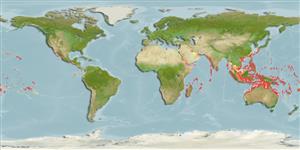分類 / Names
共通名の | 類義語 | Catalog of Fishes(部類, 種) | ITIS | CoL | WoRMS | Cloffa
>
Tetraodontiformes (Puffers and filefishes) >
Tetraodontidae (Puffers) > Canthigasterinae
Etymology: Canthigaster: Greek, kanthos = the outer or inner corner of the eye, where the lids meet, 1646 + Greek, gaster = stomach (Ref. 45335); valentini: Presumably after Gabriel Gustav Valentin (P.Adamicka, pers.comm. 11/09)..
More on author: Bleeker.
Environment: milieu / climate zone / depth range / distribution range
生態学
海 関連する礁; 深さの範囲 1 - 55 m (Ref. 1602). Tropical; 32°N - 32°S
Indo-Pacific: Red Sea south to Durban, South Africa (Ref. 4919) and east to the Tuamoto Islands, north to southern Japan, south to Lord Howe Island.
Length at first maturity / サイズ / 重さ / 年齢
Maturity: Lm 4.6, range 4 - 5.4 cm
Max length : 11.0 cm TL オス/雌雄の選別がない; (Ref. 4919)
背面の脊椎 (合計): 0; 背鰭 (合計): 9; 肛門の骨 0; 臀鰭: 9. Side with two prominent dark bars extending to belly (Ref. 559).
Found among coral heads and rocks of subtidal lagoon and seaward reefs (Ref. 4919, 5503). Common on coastal reefs at various depths. Mimic filefish, males are territorial and are often seen fighting (Ref. 48637). Feed mainly on filamentous green and red algae, tunicates, and on smaller amounts of corals, bryozoans, polychaetes, echinoderms, mollusks, and brown and coralline red algae. Form shoals (10-100 or more) often with the filefish, Paraluteres prionurus (about 5% of shoal) mimicking C. valentini to protect it from predators (Ref. 4919, 5503). Territorial and haremic; males spawn with a different female each day (Ref. 9710). One or more territories are occupied and defended each by a female where a single large male stands guard (Ref. 55082). All sexually mature females are territorial females (Ref. 55082). Demersal spawner (Ref. 35298).
Life cycle and mating behavior
成熟 | 繁殖 | 放精 | 卵 | 生産力 | 幼生
Oviparous (Ref. 205). Social and mating systems of this species are based upon female territoriality where polygyny results from males defending females occupying a certain territory (female-defense polygyny) (Ref. 55082). All sexually mature females are territorial females (Ref. 55082). Neither parent guards the eggs which are laid in a nest located in the female's territory (Ref. 46142).
During breeding, territorial females perform the 'caudal flexing with swollen abdomen display' to signal courtship and readiness to spawn. The male acknowledges with no courtship or color displays but rather by visiting the sites frequently. The territorial female then begins pecking at the substrate in preparation for egg laying. The female initiates the spawning event by pressing her abdomen into the prepared site. The territorial male quickly lays his body across her caudal peduncle and both remained in this position for 5-10 sec. The male swims away after leaving the female beating her anal fin rapidly over the nest site to ensure fertilization of the eggs and to push the eggs deep into the algal substrate (Ref. 46142). All territorial males spawn with territorial females, depriving the bachelor males of the chance to copulate which nevertheless don't interfere with the spawning between the territorial male and females (Ref. 46142).
Myers, R.F., 1991. Micronesian reef fishes. Second Ed. Coral Graphics, Barrigada, Guam. 298 p. (Ref. 1602)
人間に対する脅威
Poisonous to eat (Ref. 4919)
Human uses
水族館・水槽: 商業
より多くの情報
参考文献水産養殖水産養殖の紹介緊張遺伝子のElectrophoreses遺伝病気行列NutrientsMass conversion
用具
特記事項
XMLをダウンロードして下さい
インターネットの情報源
Estimates based on models
Preferred temperature (Ref.
123201): 24.6 - 28.9, mean 27.6 °C (based on 846 cells).
Phylogenetic diversity index (Ref.
82804): PD
50 = 0.5000 [Uniqueness, from 0.5 = low to 2.0 = high].
Bayesian length-weight: a=0.03388 (0.01902 - 0.06038), b=2.85 (2.69 - 3.01), in cm total length, based on LWR estimates for this species & Genus-body shape (Ref.
93245).
栄養段階 (Ref.
69278): 2.8 ±0.30 se; based on food items.
回復力 (Ref.
120179): 手段, 1.4年~4.4年の倍増期間の最小個体群 (Fecundity = 400).
Fishing Vulnerability (Ref.
59153): Low vulnerability (10 of 100).
Nutrients (Ref.
124155): Calcium = 113 [51, 272] mg/100g; Iron = 1.05 [0.51, 2.51] mg/100g; Protein = 17.9 [15.7, 20.1] %; Omega3 = 0.13 [0.06, 0.26] g/100g; Selenium = 39.9 [18.9, 91.4] μg/100g; VitaminA = 47.6 [12.6, 189.6] μg/100g; Zinc = 1.85 [1.19, 2.80] mg/100g (wet weight);
